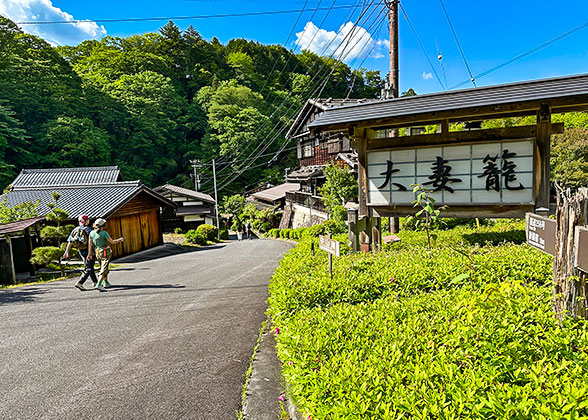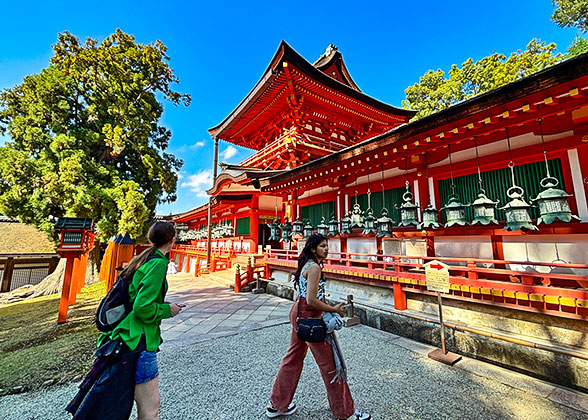Tsumago – No.42 Post Town on Nakasendo Way
Tsumago is the No.42 post town on Nakasendo Way from Tokyo, the previous to Magome. Although located in Kiso Valley and surrounded by mountains, it has been a vital point for regional transportation, as Nakasendo Way was one of the major roads around Japan in Edo Period (1603-1868 AD) and another road joined there. Later, the entire town has been well preserved and restored, making it remain the Edo style and become a hot destination for sightseeing and hiking in Kiso Valley. Getting to Tsumago, you will witness the most Edo styled post town in Kiso Valley and whole Nakasendo Way. Meanwhile, the Honjin and Waki-honjin are listed as the national cultural treasures.

Tsumago
|
Popular Hiking between Tsumago & Magome
South to Tsumago, Magome is the next post town on Nakasendo Way. The section between Tsumago and Magome, the southernmost part of Kiso Valley, is also the most-visited hiking trail on Nakasendo Way and even around the country. It is about 9 kilometers (5.6 miles) long, with more uphill trails than the downhill way to Magome. 3 hours or so is needed to finish the hiking course, and you can apply for a certificate at JPY 300 to prove that you have walked all the way as you get the hiking voucher before starting.Bear bell rental is also applied just in case. At a fee of JPY 100 and the guarantee deposit of JPY 2,000, you can get a bell at the tourist information center before hiking. When you arrive at the destination, the guarantee deposit would be refunded as you return the bell.

|
Hiking to JR Nagiso Station
In the opposite direction, you can also hike northwards to JR Nagiso Station along the Nakasendo Way. This is the nearest train station to Tsumago, at a distance of nearly 3 kilometers (1.9 miles). On the one hand, it is definitely accessible to go for hiking to Nagiso Sta. and even further northern places in Kiso Valley. On the other hand, although there are buses between Nagiso Station and Tsumago, only a few are in operation. Thus, it would also be convenient sometimes to hike through this section.Behind Nagiso Station, there is a Momosuke Bridge over the river, which is beautiful to overlook the landscapes of the river as well as both banks.
Top Things to Do at Tsumago
Masugata in Tsumago

Tsumago Waki Honjin
|
Waki Honjin Okuya of Tsumago
Usually, honjin was the lodging for seigniors in the Edo Age; while waki-honjin was the annex of honjin, providing accommodation for higher-rank officials passing by. Waki Honjin Okuya now, including the Waki Honjin and History Museum, is opened for visitors. You could see the old structure of Japanese house, with a ground stove in the center of a tatami room and byobu screen on a side. When sunshine comes into the dimly room via the old windows, the scene is pretty enchanting. At the meantime, many historical materials like the ancient articles of daily use are displayed to show the old life as well as local folks at Tsumago.The common admission ticket for Waki Honjin and the History Museum costs JPY 600 per adult. These are opened during 09:00-17:00, while closed on the 2nd & 4th Thursdays every month and New Year holidays from Dec. 29th to Jan. 3rd.

History Museum of Waki Honjin Okuya
|
Honjin of Tsumago
Honjin of Tsumago has been restored well. Together with Waki Honjin and History Museum, the three are referred as Nagiso-machi Museum. Similar structure to waki-honjin, Honjin shows an immersive atmosphere to make people feel like travelling into the ancient period, too. As a national cultural treasure in Japan, Honjin of Tsumago doesn’t open on weekdays currently, and it would be closed as well in poor weather. If Honjin is opened on weekends, JPY 300 is required for the admission ticket per adult, or JPY 700 for a common ticket of the 3 venues (Honjin, Waki Honjin & History Museum).

Honjin of Tsumago
|
Koi-iwa – Carp Rock
As the name indicates, Koi-iwa is natural rock in the shape of a big carp. It is one of the scenic spots to see in Tsumago, and was a most beautiful and best-known rock on Nakasendo Way. You can’t tell the rock looks like a carp fish perhaps, that’s because it was wrecked in a violent earthquake in 1891. Even so, the rock is still there and is a wonderful site at Tsumago.Try Local Food at Tsumago

A Restaurant at Tsumago
|
Seasonal Events – Colorful Activities to Participate
Seasonal events and traditional festivals would make Tsumago livelier and attract more visitors. Ice and Snow Festival with lamp illuminations in February, traditional puppet display in March, Wachino Shrine Matsuri on 23-24th July, and the parade of historical folk stories on 23th November are the grandest.

Display of Dolls, March
|
Accommodation at Tsumago
Accommodation is available of course in Tsumago, which are all ryokans and homestays in traditional Japanese style. These lodges are distributed on the main street of Tsumago as well as Otsumago. You could have an experience of ancient Japanese people, as staying overnight in the tatami rooms and taste the homemade folk dishes. In the traditional room, usually there is no private bathroom, and no onsen (hot spring) could be found in Tsumago.

A Ryokan at Tsumago
|
Baggage Transportation from Tsumago to Magome
It’s available to choose the baggage delivery service when you want an easier hiking journey to Magome. Baggage is accepted and can be transported to the destination on the same day.If you want a temporary delivery out of the service hours, it might be also practicable, probably. However, it takes JPY 4,500 for 1-3 pieces of baggage, and JPY 1,000 is added for each additional piece.

Tsumago Tourist Information Center
|
How to Travel to Tsumago?
Nagiso is the best and closest transfer station to reach Tsumago. After a train trip to Nagiso Station, it is easier to hike to Tsumago or get there by bus.|
Trains to JR Nagiso Sta. |
Nagiso to Tsumago |
|
The Fastest: Direct Limited Express Shinano 1h-1h 3min & JPY 2,890 from Nagoya Express/Rapid Trains: Transfer at Nakatsugawa Nagoya-Nakatsugawa-Nagiso: 1h 43min-2h & JPY 1,690 |
Hiking: around 40 min |
|
Bus: 7 min, JPY 300 |
|
|
Taxi (Nagiso Kanko Taxi): about 10 min, JPY 1,700 or so |
Notes:
Read More:
You May Like
-
 10 Days Private Tour of Tokyo - Mt. Fuji - Tokyo - Nagano - Matsumoto - Nakasendo Way - Kyoto - Osaka from USD2859
10 Days Private Tour of Tokyo - Mt. Fuji - Tokyo - Nagano - Matsumoto - Nakasendo Way - Kyoto - Osaka from USD2859 -
 8 Days Mini Group Tour to Tokyo - Hakone & Mt. Fuji - Kyoto - Nara - Osaka - Hiroshima - Osaka from USD2771
8 Days Mini Group Tour to Tokyo - Hakone & Mt. Fuji - Kyoto - Nara - Osaka - Hiroshima - Osaka from USD2771 -
 11 Days Mini Group Tour to Tokyo - Hakone (Mt. Fuji) - Kyoto - Nara - Osaka - Hiroshima - Kanazawa - Shirakawa-go - Takayama - Tokyo from USD3554
11 Days Mini Group Tour to Tokyo - Hakone (Mt. Fuji) - Kyoto - Nara - Osaka - Hiroshima - Kanazawa - Shirakawa-go - Takayama - Tokyo from USD3554


